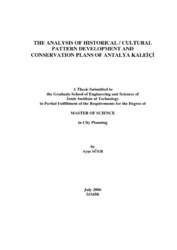Please use this identifier to cite or link to this item:
https://hdl.handle.net/11147/2948Full metadata record
| DC Field | Value | Language |
|---|---|---|
| dc.contributor.advisor | Seğmen, Ülker | en |
| dc.contributor.author | Süer, Ayşe | - |
| dc.date.accessioned | 2014-07-22T13:48:39Z | - |
| dc.date.available | 2014-07-22T13:48:39Z | - |
| dc.date.issued | 2006 | en |
| dc.identifier.uri | http://hdl.handle.net/11147/2948 | - |
| dc.description | Thesis (Masterl)--Izmir Institute of Technology, City and Regional Planning, Izmir, 2006 | en |
| dc.description | Includes bibliographical references (leaves: 117-121) | en |
| dc.description | Text in English; Abstract: Turkish and English | en |
| dc.description | x, 121 leaves | en |
| dc.description.abstract | Historical places are the physical conformation of differential relations and interactions which develop in the course of time at space. In this context; it is not sufficient for an efficient conservation plan to introduce only current urban structure in the preparation phase of the conservation plans.In this study, the urban development and transformation of historical city center of Antalya Kaleiçi has been analyzed in terms of its cultural periods, and the reflection of this historical urban structure to conservation plan decisions has been examined.The basic principle of this study is the analysis of urban pattern. In the process of the urban pattern analysis, the urban structure of Kaleiçi settlement is formed by investigating the urban structure features of each historical period and by taking into account the historical and geographical features of the Kaleiçi settlement as well.Two different urban patterns have been scrutinized in order to bring up the relationship between present and past in terms of urban structure. Consequently, it is stated that the effects of past could be observed in the development of current urban structure.As a result of the investigation of conservation plan decisions, it is found out that the historical urban structure had not been taken into account adequately when giving conservation plan decisions. Furthermore, another important absence of conservation plans, the interrelatedness of the archeological area and monumental buildings within whole urban structure, are introduced in this work.In conclusion, it is stated by setting forth the reasons that the examination of the historical urban structure as a whole necessitates not only handling urban structure in the physical sense but also investigating the urban structure in terms of historical and cultural integrity.In this study, additionally, a methodological approach for the analysis of historical urban structures has been introduced as a model for further conservation plans. | en |
| dc.language.iso | en | en_US |
| dc.publisher | Izmir Institute of Technology | en |
| dc.rights | info:eu-repo/semantics/openAccess | en_US |
| dc.subject.lcc | NA9053.C6 .S43 2006 | en |
| dc.subject.lcsh | Historic sites--Conservation and restoration--Turkey--Antalya | en |
| dc.subject.lcsh | Historic preservation--Turkey--Planning | en |
| dc.subject.lcsh | City planning--Turkey--Antalya--History | en |
| dc.title | The analysis of historical / cultural pattern development and conservation plans of Antalya Kaleiçi | en_US |
| dc.type | Master Thesis | en_US |
| dc.institutionauthor | Süer, Ayşe | - |
| dc.department | Thesis (Master)--İzmir Institute of Technology, City and Regional Planning | en_US |
| dc.relation.publicationcategory | Tez | en_US |
| item.openairecristype | http://purl.org/coar/resource_type/c_18cf | - |
| item.grantfulltext | open | - |
| item.cerifentitytype | Publications | - |
| item.fulltext | With Fulltext | - |
| item.openairetype | Master Thesis | - |
| item.languageiso639-1 | en | - |
| Appears in Collections: | Master Degree / Yüksek Lisans Tezleri | |
Files in This Item:
| File | Description | Size | Format | |
|---|---|---|---|---|
| T000545.pdf | MasterThesis | 32.34 MB | Adobe PDF |  View/Open |
CORE Recommender
Page view(s)
306
checked on Nov 18, 2024
Download(s)
290
checked on Nov 18, 2024
Google ScholarTM
Check
Items in GCRIS Repository are protected by copyright, with all rights reserved, unless otherwise indicated.